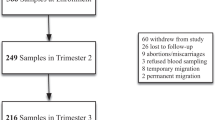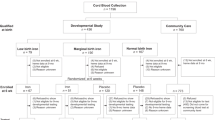Abstract
Objective:
To examine zinc-protoporphyrin (ZPP) and haemoglobin levels, and to determine predictors of iron deficiency anaemia (IDA) in Zambian infants.
Subjects and methods:
Ninety-one women and their normal birth weight (NBW) infants were followed bi-monthly during the first 6 months of life, and iron status, food intake, malaria parasitaemia and growth were monitored. At 4 months, the infants were divided into two groups, and the data were analysed according to whether or not they were exclusively breastfed.
Results:
Almost two-third of infants were born with low iron stores as defined by ZPP levels, and this proportion increased with age. Over 50% had developed IDA by 6 months. Exclusive breastfeeding at 4 months could be a protective factor for IDA (odds ratio (OR): 0.2; 95% confidence interval (CI): 0.0–1.1). Exclusively breastfed infants had higher haemoglobin values at 4 and 6 months (mean difference 0.6; 95% CI: 0.1–1.2 g/dl and mean difference 0.9; 95% CI: 0.2–1.7 g/dl, respectively), compared with infants with early complementary feeding. In univariate analysis, past or chronic placental malaria appeared to be a predictor of IDA at 4 and 6 months, but the significance was lost in multivariate analysis.
Conclusions:
Zambian NBW infants are born with low iron stores and have a high risk to develop IDA in the first 6 months of life. Continuation of exclusive breastfeeding after 4 months is associated with a reduction of anaemia. The effect of placental malaria infection on increased risk of infant IDA could not be proven.
This is a preview of subscription content, access via your institution
Access options
Subscribe to this journal
Receive 12 print issues and online access
$259.00 per year
only $21.58 per issue
Buy this article
- Purchase on Springer Link
- Instant access to full article PDF
Prices may be subject to local taxes which are calculated during checkout


Similar content being viewed by others
References
Arifeen S, Black RE, Antelman G, Baqui A, Caulfield L, Becker S (2001). Exclusive breastfeeding reduces acute respiratory infection and diarrhea deaths among infants in Dhaka slums. Pediatrics 108, E67.
Asobayire F, Adou P, Daviddson L, Cook JD, Hurrell R (2001). Prevalence of iron deficiency with and without concurrent anemia in population groups with high prevalences of malaria and other infections: a study in Cote d'Ivoire. Am J Clin Nutr 74, 776–782.
Brabin B (1992). Fetal anaemia in malarious areas: its causes and significance. Ann Trop Paediatr 12, 303–310.
Brabin BJ, Kalanda BF, Verhoeff FH, Chimsuku L, Broadhead RL (2004b). Risk factors for fetal anaemia in a malarious area of Malawi. Ann Trop Paediatr 24, 311–324.
Brabin BJ, Premji Z, Verhoeff F (2001). An analysis of anemia and child mortality. J Nutr 131, 636S–645S.
Brabin BJ, Prinsen-Geerligs P, Verhoeff F, Kazembe P (2003). Anaemia prevention for reduction of mortality in mothers and children. Trans R Soc Trop Med Hyg 97, 36–38.
Brabin BJ, Prinsen-Geerligs PD, Verhoeff FH, Fletcher KA, Chimsuku LH, Ngwira BM et al. (2004). Haematological profiles of the people of rural southern Malawi: an overview. Ann Trop Med Parasitol 98, 71–83.
Brabin BJ, Romagosa C, Abdelgalil S, Menendez C, Verhoeff FH, McGready R et al. (2004a). The sick placenta—the role of malaria. Placenta 25, 359–378.
Cornet M, Le Hesran JY, Fievet N, Cot M, Personne P, Gounoue R et al (1998). Prevalence of and risk factors for anemia in young children in southern Cameroon. Am J Trop Med Hyg 58, 606–611.
Crawley J (2004). Reducing the burden of anemia in infants and young children in malaria-endemic countries of Africa: from evidence to action. Am J Trop Med Hyg 71, 25–34.
Dallman PR (1988) In: R Tsang, B Nichols (eds) Nutrition During Infancy. Hanley and Belfus Inc: Philadelphia, PA. pp 217.
Dewey KG, Cohen RJ, Brown KH (2004). Exclusive breast-feeding for 6 months, with iron supplementation, maintains adequate micronutrient status among term, low-birthweight, breast-fed infants in Honduras. J Nutr 134, 1091–1098.
Dewey KG, Cohen RJ, Brown KH, Rivera LL (1999). Age of introduction of complementary foods and growth of term, low-birth-weight, breast-fed infants: a randomized intervention study in Honduras. Am J Clin Nutr 69, 679–686.
Domellof M, Dewey KG, Lonnerdal B, Cohen RJ, Hernell O (2002). The diagnostic criteria for iron deficiency in infants should be reevaluated. J Nutr 132, 3680–3686.
Dorea J (2000). Iron and copper in human milk. Nutrition 16, 209–220.
Fuchs R, Ellinger I (2004). Endocytic and transcytotic processes in villous syncytiotrophoblast: role in nutrient transport to the human fetus. Traffic 5, 725–738.
Grantham-McGregor S, Ani C (2001). A review of studies on the effect of iron deficiency on cognitive development in children. J Nutr 131, 649S–666S.
Griffin IJ, Abrams SA (2001). Iron and breastfeeding. Pediatr Clin N Am 48, 401–413.
Hinchliffe R (1999). Reference values. In: J Lilleyman, I Hahn, V Blanchette (eds). Pediatric Hematology, 2nd edn.Churchill Livingstone: London.
INACG (1985). Measurements of Iron Status. International Life Sciences Institute: Washington, DC.
Ismail MR, Ordi J, Menendez C, Ventura PJ, Aponte JJ, Kahigwa E et al (2000). Placental pathology in malaria: a histological, immunohistochemical, and quantitative study. Hum Pathol 31, 85–93.
Jones G, Steketee RW, Black RE, Bhutta ZA, Morris SS (2003). How many child deaths can we prevent this year? Lancet 362, 65–71.
Juul S, Zerzan J, Strandjord T, Woodrum D (2003). Zinc protoporphyrin/heme as an indicator of iron status in NICU patients. J Pediatr 142, 273–278.
Kalanda BF, Verhoeff FH, Brabin BJ (2006). Breast and complementary feeding practices in relation to morbidity and growth in Malawian infants. Eur J Clin Nutr 60, 401–407.
Kitua AY, Smith TA, Alonso PL, Urassa H, Masanja H, Kimario J et al (1997). The role of low level Plasmodium falciparum parasitaemia in anaemia among infants living in an area of intense and perennial transmission. Trop Med Int Health 2, 325–333.
Kling P (2006). The zinc protoporphyrin/heme ration in premature infants: has it found its place? J Pediatr 148, 8–10.
Kramer M, Kakuma R (2002). Optimal duration of exclusive breastfeeding. Cochrane Database Syst Rev 1, (Art. No. CD003517. DOI 10.1002/14651858.CD003517).
le Cessie S, Verhoeff FH, Mengistie G, Kazembe P, Broadhead R, Brabin BJ et al. (2002). Changes in haemoglobin levels in infants in Malawi: effect of low birth weight and fetal anaemia. Arch Dis Child Fetal Neonatal Ed 86, F182–F187.
Letsky EA (1991). The haematological system. In: FE Hytten, G Chamberlain (eds). Clinical Physiology in Obstetrics. Blackwell Science: Oxford, pp 2–75.
Lott D, Zimmerman M, Labbe RF, Kling P, Widness J (2006). Erythrocyte zinc protoporphyrin ratios are elevated with prematurity and with fetal hypoxia. Pediatrics 116, 414–422.
Michaelsen KF, Milman N, Samuelson G (1995). A longitudinal study of iron status in healthy Danish infants: effects of early iron status, growth velocity and dietary factors. Acta Paediatr 84, 1035–1044.
Miettinen OS (1983). The need for randomization in the study of intended effects. Stat Med 2, 267–271.
Miller MF, Stoltzfus RJ, Mbuya NV, Malaba LC, Iliff PJ, Humphrey JH et al (2003). Total body iron in HIV-positive and HIV-negative Zimbabwean newborns strongly predicts anemia throughout infancy and is predicted by maternal hemoglobin concentration. J Nutr 133, 3461–3468.
Nduati R, John G, Mbori-Ngacha D, Richardson B, Overbaugh J, Mwatha A et al (2000). Effect of breastfeeding and formula feeding on transmission of HIV-1. A randomised clinical trial. JAMA 283, 1167–1174.
Oski FA (1993). Iron deficiency in infancy and childhood. N Engl J Med 329, 190–193.
Picciano M (2001). Nutrient composition of human milk. Pediatr Clin N Am 48, 53–67.
Redd SC, Wirima JJ, Steketee RW (1994). Risk factors for anemia in young children in rural Malawi. Am J Trop Med Hyg 51, 170–174.
Rettmer R, Carlson T, Origenes M, Jack R, Labbe R (1999). Zinc protoporphyrin/heme ratio for diagnosis of preanemic iron deficiency. Pediatrics 104, e37.
Saarinen UM, Siimes MA (1978). Developmental changes in red blood cell counts and indices of infants after exclusion of iron deficiency by laboratory criteria and continuous iron supplementation. J Pediatr 92, 412–416.
Schellenberg D, Schellenberg JR, Mushi A, Savigny D, Mgalula L, Mbuya C et al (2003). The silent burden of anaemia in Tanzanian children: a community-based study. Bull World Health Organ 81, 581–590.
Serjeant GR, Grandison Y, Mason K, Serjeant B, Sewell A, Vaidya S (1980). Haematological indices in normal negro children: a Jamaican cohort from birth to five years. Clin Lab Haematol 2, 169–178.
Soldin O, Miller M, Soldin S (2003). Pediatric reference ranges for zinc protoporphyrin. Clin Biochem 36, 21–25.
Srai S, Bomford A, McArdle H (2002). Iron transport across cell membranes: molecular understanding of duodenal and placental iron uptake. Best Pract Res Clin Haematol 15, 243–259.
Stoltzfus RJ, Chwaya HM, Montresor A, Albonico M, Savioli L, Tielsch JM (2000). Malaria, hookworms and recent fever are related to anemia and iron status indicators in 0- to 5-y old Zanzibari children and these relationships change with age. J Nutr 130, 1724–1733.
van Eijk AM, Ayisi JG, Ter Kuile FO, Misore AO, Otieno JA, Kolczak MS et al (2002). Malaria and human immunodeficiency virus infection as risk factors for anemia in infants in Kisumu, western Kenya. Am J Trop Med Hyg 67, 44–53.
van Rheenen PF, de Moor LTT, Eschbach S, de Grooth H, Brabin BJ (2007). Delayed cord clamping and haemoglobin levels in infancy: a randomised controlled trial in term babies. Trop Med Int Health 12, 603–616.
Verhoeff FH, Milligan P, Brabin BJ, Mlanga S, Nakoma V (1997). Gestational age assessment by nurses in a developing country using the Ballard method, external criteria only. Ann Trop Paediatr 17, 333–342.
WHO (2001). Iron Deficiency Anaemia. Assessment, prevention and control. A guide for programme managers, WHO/NHD/01.3. World Health Organization: Geneva.
Acknowledgements
We thank the management board of Mpongwe Mission Hospital for their hospitality; and maternity and laboratory staff for their assistance. This study received financial support from the Amsterdam–Liverpool Programme for research in Tropical Child Health and from the Bemmel Support Group.
Author information
Authors and Affiliations
Corresponding author
Additional information
Guarantor: PF van Rheenen.
Contributors: PFvR and BJB were responsible for the study idea and design. Both contributed to the analysis and interpretation of the data and to the writing of the paper. LTTdM and SE collected the data.
Competing interests
None declared.
Rights and permissions
About this article
Cite this article
van Rheenen, P., de Moor, L., Eschbach, S. et al. A cohort study of haemoglobin and zinc protoporphyrin levels in term Zambian infants: effects of iron stores at birth, complementary food and placental malaria. Eur J Clin Nutr 62, 1379–1387 (2008). https://doi.org/10.1038/sj.ejcn.1602862
Received:
Revised:
Accepted:
Published:
Issue Date:
DOI: https://doi.org/10.1038/sj.ejcn.1602862
Keywords
This article is cited by
-
Complementary food with low (8%) or high (12%) meat content as source of dietary iron: a double-blinded randomized controlled trial
European Journal of Nutrition (2010)



